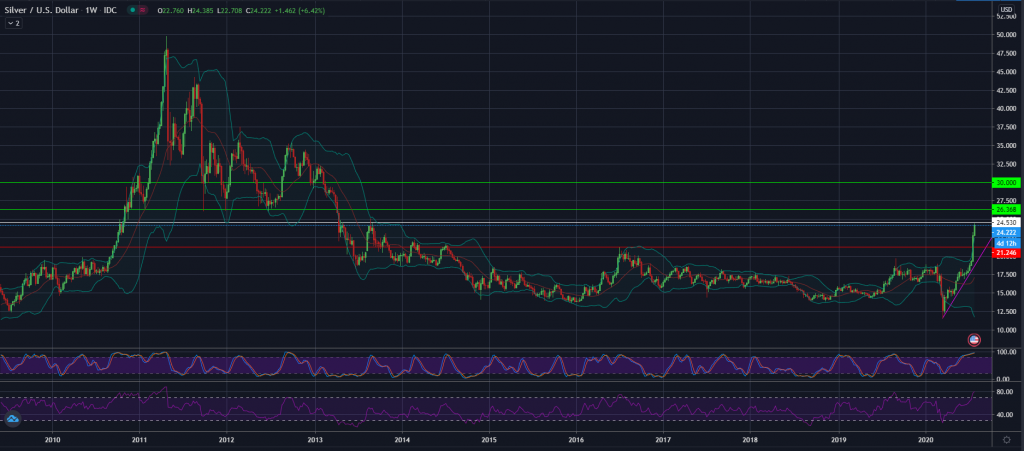Neumeyer has voiced this opinion many times, giving the US$130 number in a November 2017 interview with Palisade Radio and again in March 2018 with Kitco. In the past, he’s been even bolder, suggesting the white metal could reach US$1,000.
let’s dive a little deeper into Neumeyer’s prediction that the white metal can break the seemingly distant US$130 level.
Why $130?
There is a significant length for the silver price to go before it reaches the success Neumeyer has boldly predicted. For the precious metal to jump to US$130, its price would have to increase by close to eight times its current value.
Neumeyer sees US$130 silver in the cards in part because he believes the current market compares to the year 2000 when investors were sailing high on the dot-com bubble and the mining sector was down. The First Majestic Silver CEO thinks it’s only a matter of time before the market corrects as it did in 2001 and 2002, and mining sees a big rebound in pricing. It was during this time that Neumeyer himself invested heavily in mining stocks and came out on top.
Neumeyer emphasized that he trusts in silver’s supply and demand fundamentals to move the markets. “The headlines stuff that we read every day, whether it’s Trump or China … those will move markets for sure, but it doesn’t move supply and demand.” He pointed out that today’s booming solar panel and electric car markets are two huge drivers of silver consumption, “so the supply/demand fundamentals for the metal today are even more dramatic” than in years past.
More controversially, Neumeyer believes the white metal will become uncoupled from gold and should be a strategic metal due to its necessity in many everyday appliances, from computers to electronics to solar panels. He has also stated that silver production has gone down in recent years, meaning that contrary to popular belief, the metal is a rare commodity.
What factors affect its movements?
To glean a better understanding of the precious metal’s chances of trading around the US$130 range, it’s important to examine the factors that can push it to that level or pull it further away.
The strength of the US dollar, US Federal Reserve interest rate changes, and quantitative easing by central banks are all factors that will continue to affect the precious metal, as well as geopolitical issues and elements of supply and demand. Although Neumeyer believes that the tie that binds silver to gold needs to be broken, the reality is that most of the same factors that shape the price of gold also move silver.
For that reason, it is helpful to look at gold price drivers when trying to understand silver’s price action in the last year. Silver is, of course, the more volatile of the two precious metals, but it often trades in relative tandem with gold.
For gold, and by extension silver, a key price driver lately has not been so much supply and demand, but uncertainty. The past 12 months have been filled with major geopolitical events such as the tensions between the US and other countries such as North Korea, China, and Iran. Those tensions and other developments, such as the huge economic impact of the coronavirus pandemic, have been major sources of concern for investors in the precious metals market.
Precious metals investors have also been closely following the Fed’s interest rate plans. Rate cuts are generally positive for physical silver and gold bullion prices because when rates are lower it is more profitable to invest in precious metals rather than in products that can accrue interest.
The Fed recently dropped interest rates to zero, a move that has positively affected both metals. Further rate cuts remain front and center in many investors’ minds — and for good reason. The Fed continues to have a dovish tone for the remainder of the year. Market participants should also pay attention to what central banks do going forward, as it could have a large impact on the white metal.
Silver’s close ties to gold’s safe-haven status will be beneficial in the long term, and there is also a strong case to made for silver’s industrial growth potential. “Maybe countries will be looking at how do they kickstart their economies, and maybe that’ll be growth in infrastructure spending,” Philip Newman of Metals Focus said in an interview with Investing News Network. “I think that could benefit silver.”
The latest World Silver Survey, published by the Silver Institute and Metals Focus, indicates that in 2019 the silver market experienced an overall global silver supply increase despite a 1 percent decrease in mine production. In 2020, mine production is expected to fall 5 percent to 797 million ounces, while overall global silver supply is projected to drop by 4 percent to 978 million ounces. That would be the lowest level in global silver supply since 2009.
On the silver demand side, the electric vehicle and photovoltaic markets contributed greatly to increased silver consumption in 2019. “Photovoltaic demand registered an impressive 7 percent increase in offtake, rising to its second-highest annual level,” as per the report.
Last year, investor demand for silver recorded its highest increase since 2015, rising 12 percent to hit 186.1 million ounces. Holdings in exchange-traded products experienced their largest annual growth since 2010, up 13 percent to 728.9 million ounces.
For 2020, physical silver investment, such as silver bullion coins and silver bars, could see the third year of growth, rising 16 percent to 215 million ounces. “Silver physical investment is forecast to extend its gains this year, with a projected 16 percent rise to a five year high as investors rotate out of equities in search of safe-haven vehicles,” notes the report.
Silver LONG (Buy)
ENTER AT: 24.530
T.P_1: 26.368
T.P_2: 30
S.L: 21.246



